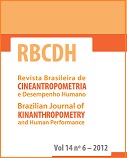Program "VAMOS" (Active Living, Enhancing Health): From Conception to Initial Findings.
DOI:
https://doi.org/10.1590/1980-0037.2012v14n6p723Abstract
Despite increased governmental efforts towards promoting healthy and active lifestylesamong Brazilians, physical inactivity is a serious concern in the population. Therefore, wedeveloped a new approach to community interventions for the promotion of physical activitycalled “Project VAMOS: Active Living, Enhancing Health”. In this article we review information about the conception of the program, as well as name, brand, and logo development. We discussissues related to translation and cultural adaptation, evaluation strategies, and we review lessonslearned from the pilot phase of the project that involved older adults and public health centers(CS) in Florianopolis. One hundred older adults registered in six CS participated in the pilot study.They were randomly assigned into three different groups: “VAMOS” (n=33), traditional physicalactivity classes (n=35), and a control group (n=32). “VAMOS” is an educational program basedon behavioral change principles that consists of 12 meetings. Based on an American evidence--based program (“Active Living Every Day”), “VAMOS” was translated and culturally adaptedto the Brazilian context. A number of adjustments were made to the original American versionof the program prior to conducting the pilot study. For example, the content of the lessons andhomework were revised, we shortened the length of the lessons, as well as lowered the complexityof some of the materials. The results of the pilot study suggest that there was broad acceptanceof the “VAMOS“program by the older adult participants. Also, interviews with administrativestaff and health professionals working for the CS indicated a possibility and interest to continueto offer “VAMOS” as part of their regular programming for the community. In summary, “VAMOS”has great potential to be used with the Brazilian population. Adjustments are necessaryfor its utilization with other age groups and across different regions in Brazil.



